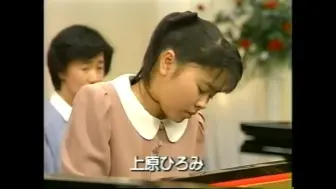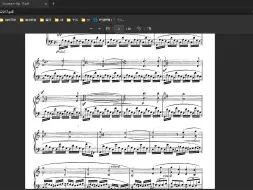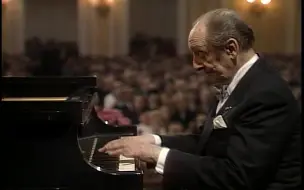【钢琴】舒曼 - C大调幻想曲 Op.17(霍洛维茨演奏)Schumann - Fantasie in C major (Vladimir Horowitz)
TIP! Right-click and select "Save link as..." to download.
| VIDEOS | |||
| MP4 | N/A | 480P | Download |
| MP4 | N/A | 480P | Download |
| MP4 | N/A | 360P | Download |
| MP4 | N/A | 360P | Download |
| AUDIO | |||
| MP4 | N/A | mp4a.40.2 | Download |
| MP4 | N/A | mp4a.40.2 | Download |
| THUMBNAILS | |||

|
JPEG | Origin Image | Download |
https://www.youtube.com/watch?v=l5cmBah0F20
霍洛维茨演奏舒曼C大调幻想曲 Op.17
Vladimir Horowitz plays Schumann Fantasie Op.17 in C major
《C大调幻想曲》Fantasie in C Major Op.17 是舒曼创作的结构庞大的钢琴曲,乐曲中充满了无限的热情。
在创作这首乐曲时,他正为克拉拉的父亲以强硬手段拆散他与克拉拉之间的关系而深感苦恼,这一苦恼也在乐曲中发泄了出来。舒曼在给克拉拉的信中写着:“对于这个幻想曲,只要你想起来我再也无法接近你而不得不把你忘怀的1836年的不幸的夏天,你就可以理解的。”在1838年出版时,出版社将此曲名定为 《幻想曲》,各乐曲的标题也没有了。当时舒曼将此曲献给了李斯特。
第一乐章,C大调,4/4拍,要彻底地保持幻想而且热情的进行演奏。舒曼在给克拉拉的信中表示:“第一乐章可能是我以往所作的最热情的乐曲--因你而起的深沉的悲歌”。这个乐章虽是以贝多芬风格的奏鸣曲形式写成,但其主题的呈示方式及发展手法都完全是十足的浪漫风格。在波浪型的十六分音符的伴奏下,呈示出热情的第一主题,之后不断提高其热情及力度进入第二主题,第二主题仍为第一主题热情的延续。展开部没有贝多芬那样的戏剧性,二十充满了富于情感的浪漫风格。在很短的再现部后摘录了一段贝多芬的“给遥远的爱人”,然后轻轻地结束。
第二乐章,降E大调,4/4拍,是兴奋热烈的进行曲,给人“得胜获奖”的感觉。在演奏上需要很多的技巧。乐章强有力地开始,然后变成附点音符的节奏,曲中有很多模仿手法。中段进入降A大调,速度缓慢,然后回到开始部分,其中加进了其他乐思。
第三乐章,C大调,12/8拍,作者提示“要缓慢的演奏,必须保持安稳”。这一乐章是像梦幻一样平静而安稳的乐曲,非常富有诗意。在轻快的琶音伴奏之后,接着随三连音出现像大提琴一样的第一主题旋律,随后,转为降A大调,继低音的旋律之后出现优美的第二主题,经发展后进入再现部。再现部后是尾声,以琶音的伴奏音型平静地结束全曲。这种温和的结束方法很有舒曼自己的风格,充满了优美的浪漫韵味。
-------------------------------------------
The Fantasie in C major, Op. 17, was written by Robert Schumann in 1836. It was revised prior to publication in 1839, when it was dedicated to Franz Liszt. It is generally described as one of Schumann's greatest works for solo piano, and is one of the central works of the early Romantic period. It is often called by the Italian version, Fantasia; the word "Fantasie" is the German spelling.
The Fantasie is in loose sonata form. Its three movements are headed:
-Durchaus fantastisch und leidenschaftlich vorzutragen; Im Legenden-Ton
-Mäßig. Durchaus energisch
-Langsam getragen. Durchweg leise zu halten.
The first movement is rhapsodic and passionate; the middle movement (in E flat major) is a grandiose rondo based on a majestic march, with episodes that recall the emotion of the first movement; and the finale is slow and meditative.
霍洛维茨演奏舒曼C大调幻想曲 Op.17
Vladimir Horowitz plays Schumann Fantasie Op.17 in C major
《C大调幻想曲》Fantasie in C Major Op.17 是舒曼创作的结构庞大的钢琴曲,乐曲中充满了无限的热情。
在创作这首乐曲时,他正为克拉拉的父亲以强硬手段拆散他与克拉拉之间的关系而深感苦恼,这一苦恼也在乐曲中发泄了出来。舒曼在给克拉拉的信中写着:“对于这个幻想曲,只要你想起来我再也无法接近你而不得不把你忘怀的1836年的不幸的夏天,你就可以理解的。”在1838年出版时,出版社将此曲名定为 《幻想曲》,各乐曲的标题也没有了。当时舒曼将此曲献给了李斯特。
第一乐章,C大调,4/4拍,要彻底地保持幻想而且热情的进行演奏。舒曼在给克拉拉的信中表示:“第一乐章可能是我以往所作的最热情的乐曲--因你而起的深沉的悲歌”。这个乐章虽是以贝多芬风格的奏鸣曲形式写成,但其主题的呈示方式及发展手法都完全是十足的浪漫风格。在波浪型的十六分音符的伴奏下,呈示出热情的第一主题,之后不断提高其热情及力度进入第二主题,第二主题仍为第一主题热情的延续。展开部没有贝多芬那样的戏剧性,二十充满了富于情感的浪漫风格。在很短的再现部后摘录了一段贝多芬的“给遥远的爱人”,然后轻轻地结束。
第二乐章,降E大调,4/4拍,是兴奋热烈的进行曲,给人“得胜获奖”的感觉。在演奏上需要很多的技巧。乐章强有力地开始,然后变成附点音符的节奏,曲中有很多模仿手法。中段进入降A大调,速度缓慢,然后回到开始部分,其中加进了其他乐思。
第三乐章,C大调,12/8拍,作者提示“要缓慢的演奏,必须保持安稳”。这一乐章是像梦幻一样平静而安稳的乐曲,非常富有诗意。在轻快的琶音伴奏之后,接着随三连音出现像大提琴一样的第一主题旋律,随后,转为降A大调,继低音的旋律之后出现优美的第二主题,经发展后进入再现部。再现部后是尾声,以琶音的伴奏音型平静地结束全曲。这种温和的结束方法很有舒曼自己的风格,充满了优美的浪漫韵味。
-------------------------------------------
The Fantasie in C major, Op. 17, was written by Robert Schumann in 1836. It was revised prior to publication in 1839, when it was dedicated to Franz Liszt. It is generally described as one of Schumann's greatest works for solo piano, and is one of the central works of the early Romantic period. It is often called by the Italian version, Fantasia; the word "Fantasie" is the German spelling.
The Fantasie is in loose sonata form. Its three movements are headed:
-Durchaus fantastisch und leidenschaftlich vorzutragen; Im Legenden-Ton
-Mäßig. Durchaus energisch
-Langsam getragen. Durchweg leise zu halten.
The first movement is rhapsodic and passionate; the middle movement (in E flat major) is a grandiose rondo based on a majestic march, with episodes that recall the emotion of the first movement; and the finale is slow and meditative.

























